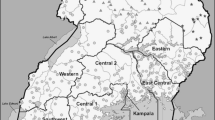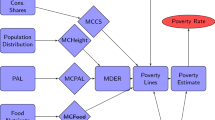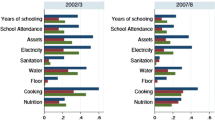Abstract
The primus inter pares of the UN-approved Millennium Development Goals is to reduce poverty. The only internationally accepted method of estimating poverty requires a measurement of total consumption based on a time-consuming and resource-demanding measure of household expenditure in an integrated survey over 12 months. Rather than measuring poverty, say, only every fifth year, a model is presented to predict poverty based on a small set of household variables to be collected annually between two 12-monthly household surveys. Information obtained from these “light” surveys might then be used to predict poverty rates. The key question is whether the inaccuracy in these predictions is acceptable. It is recommended that these models be tested at a country level and if the test results are similar to those found here, that this approach be adopted.
Similar content being viewed by others
References
Elbers, C., Lanjouw, J.O., Lanjouw, P.: Micro level estimation of poverty and inequality. Econometrica 71(1), 355–364 (2003)
Deaton, A.: The analysis of household surveys. A microeconometric approach to development policy. The Johns Hopkins University Press, Baltimore, MD (1997)
Deaton, A., Grosh, M.: Consumption. In: Grosh, M., Glewwe, P. (eds) Designing Household Survey Questionnaires for Developing Countries: Lessons from 15 Years of the Living Standards Measurement Study, vol. 1, pp. 91–133. Oxford University Press for the World Bank (2000)
Fofack, H.: Combining light monitoring surveys with integrated surveys to improve targeting for poverty reduction: the case of Ghana. World Bank Econ. Rev. 14(1), 195–219 (2000)
Greene, W.: Econometric analysis. Prentice-Hall, Englewood Cliffs, NJ (2003)
Hentschel, J., Lanjouw, J.O., Lanjouw, P., Poggi, J.: Combining census and survey data to trace the spatial dimensions of poverty: a case study of Ecuador. World Bank Econ. Rev. 14(1), 195–218 (2000)
Johnson, M., McKay, A., Round, J.: Income and expenditure in a system of household accounts: Concepts and estimation. Social dimensions of adjustment. Working Paper No. 10. The World Bank, Washington DC (1990)
McKay, A.: Report on investigating the development of a poverty correlates model for Uganda. Report prepared for Poverty Monitoring and Analysis Unit (PMAU), Ministry of Finance, Uganda and Department for International Development (DFID), Kampala (2001)
Minot, N.: Are poor, remote areas left behind in agricultural development: The case of Tanzania. MTID Discussion Paper, No. 90, IFPRI (2005)
National Directorate of Planning and Budget, Economic Research Bureau, International Food Policy Research Institute and Purdue University: Poverty and well-being in Mozambique: The Second National Assessment (2004)
Ravallion, M.: Poverty comparison: A guide to concepts and methods. LSMS Working Paper No. 88. The World Bank (1992)
Ravallion, M.: Poverty lines in theory and practice. LSMS Working Paper No. 133. The World Bank (1998)
Sverdrup, E.: Laws and chance variations. Universitetsforlaget, Oslo (1967)
Tarozzi, A.: Calculating comparable statistics from incomparable surveys, with an application to poverty in India. J. Bus. Econom. Stat. (forthcoming)
Wooldridge, J.M.: Econometric analysis of cross section and panel data. MIT Press, Cambridge, MA (2002)
Author information
Authors and Affiliations
Corresponding author
Rights and permissions
About this article
Cite this article
Mathiassen, A. A model based approach for predicting annual poverty rates without expenditure data. J Econ Inequal 7, 117–135 (2009). https://doi.org/10.1007/s10888-007-9059-7
Received:
Accepted:
Published:
Issue Date:
DOI: https://doi.org/10.1007/s10888-007-9059-7




